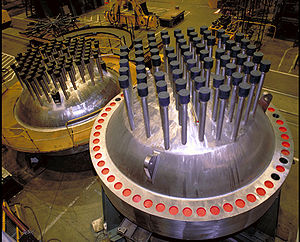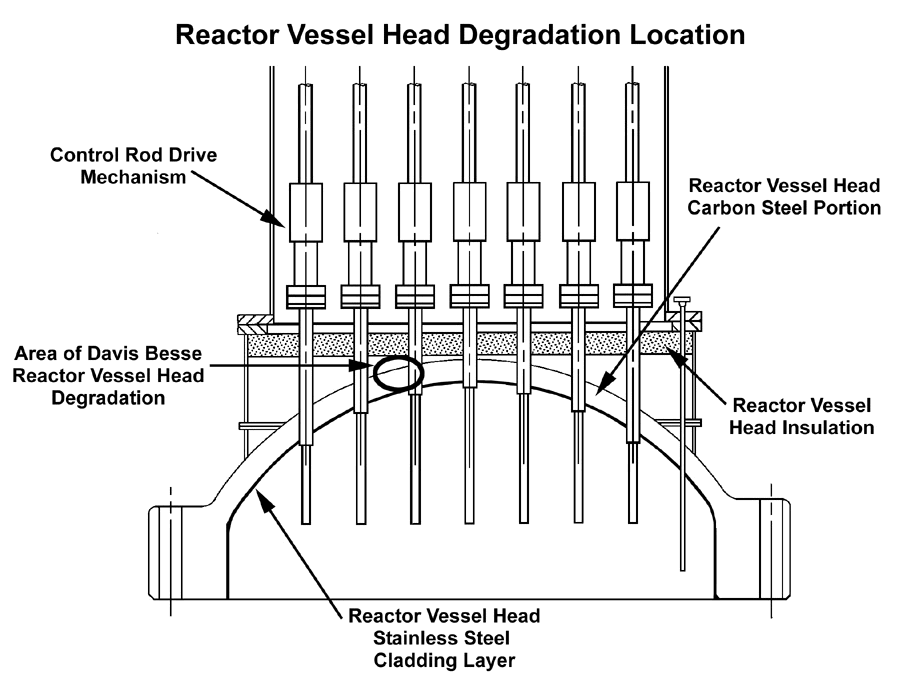
Most likely PWR LOCA?
Loss of coolant accident
The greatest advantage of the pressurised-water reactor (PWR) is the provision of a massive amount of thermal energy in a small space, but this ranks as its primary disadvantage in that its uncontrolled release can destroy not only its source, but contaminate the surrounding, neighbouring land.
The two candidates for the UK’s new nuclear build, the
Areva EPR and the Westinghouse AP1000 provide 4,500 MWh and 3,415 MWh of thermal
energy respectively which is transferred by a light water coolant circulated
through four or two steam
generators to produce steam for the generator turbines. The light water heat
transfer medium also acts as a moderator, slowing down neutron emissions
affording more collisions with fuel nuclei and producing adequate fission.
To produce an adequate temperature of 330°C to 320°C requires a water pressure of 13 MPa to 11.5 MPa to maintain its state as saturated water, but is held at an operating pressure of 15.5 MPa to provide a margin of security to avoid the production of flash steam.
The significance of a loss of coolant is that a drop in the operating pressure below that equivalent to the saturation temperature turns the coolant into a two-phase mixture of water and steam, reducing the heat transfer from the fuel rods to the coolant. This results in a temperature rise in the zirconium alloy fuel rod cladding which then oxidises exothermally from the oxygen in the steam, releasing hydrogen. The cladding and the fuel rods’ temperature rises to around 1,000°C and above, melting the uranium oxide fuel and heating the hydrogen above its auto-ignition temperature of 585°C so that it ignites when it meets the external air.
The prevention of a LOCA and the amelioration of its consequences has therefore been a crucial aspect of the PWR’s operation. PWRs are provided with Emergency Core Cooling Systems (ECCSs), the initiation of which involves the reduction of the coolant system pressure (“blowing-down”) to a level at which coolant and boric acid solution can be injected. The consequences of the initial blow down inevitably lead to a partial meltdown of the fuel core, so although the consequences of a LOCA may be ameliorated by an ECCS, the reactor is a write-off.
It is important therefore to consider the potential causes of a LOCA and the most likely incident leading to one and its consequences.
Incidents at Davis-Besse (2002) and Sizewell B (2010)
represent the worse and perhaps the least serious LOCAs in recent times.
At Davis-Besse unnoticed cracks in a Control Rod Drive
Mechanism (CRDM) nozzle (“penetration”) allowed leaking boric acid to eat a
large hole in its reactor vessel head’s ferritic outer shell, revealing a
cracked inner stainless steel liner, which fortunately held the internal
pressure.
At Sizewell B leaking electric heaters and/or nozzles
(“penetrations”) on the underside of the coolant pressuriser were detected
by radiation monitoring in the containment. The LOCA resulted in a 6 months
shutdown for repairs. A further shtudown was required in 2011 to replace all the
heaters.
The cracks are assumed to be caused by stress corrosion
cracking of the alloy steels employed. In particular the use of the universally
employed alloy 600 has now been
abandoned in favour of alloy 690, which contains twice the content of chromium.
Although subjected to a massive fine by the US regulator,
the Davis-Besse management cancelled an order for a replacement reactor vessel
head using alloy 690 for its CRDM nozzles when it located an unused head with
alloy 600 nozzles. This only endured for 6 years, when cracks in the nozzles
appeared and it had to be patched up pending the re-ordered replacement head is
delivered in 2012.
As well as CRDM and pressuriser nozzles, alloy 690 is now
specified for steam generator tubes. The use of this substituted metal and crack
generation in particular is therefore worthy of study.
Irradiation assisted stress corrosion cracking (IASCC) refers to the acceleration of the SCC process by neutron irradiation. It is well-known that irradiation causes stainless steel embrittlement. Neutron bombardment of boron, a component of the control rods (and added to the reactor coolant as boric acid as neutron absorber) converts it to helium and tritium. As hydrogen diffuses through steels, so also will tritium as a hydrogen isotope, so that while it passes through it will produce radiation internally.
As
a significant ageing problem for reactors, IASCC and crack propagation are the
subject of many studies of this complex problem, but for simplicity it can be
quantified for alloy 600 in the case of the Davis-Besse replacement head failure
after 6 years. The nozzle is 4” diameter with a 1-3/4“ bore with a wall
thickness of 15.8 mm. So a CRDM nozzle wall of 15.8 mm was breached by cracks at
a rate of 15.8/6 = 2.63 mm/y.
Argonne
Laboratory found the “SCC
crack growth rates in simulated PWR water at 320°C are in the 10-11
m/s range for cold-rolled Alloy 690 and as-welded Alloy 152”. At this rate the CRDM nozzle wall would
have been breached in 51 years at a rate of 0.31 mm/y or that alloy 690 has a
crack resistance 8.5 times better than alloy 690.
It is clear that alloy 690 has a higher
crack resistance than alloy 600, but is it 8.5 times better? It depends on how
near to actual reactor conditions the tests were able to produce and whether any
test can represent an ageing process. Will the progressive ingress of tritium
accelerate the crack growth? In any case the reactor manufacturers are claiming
an operational life of 60 years, possible extending to 80 years, so the life
span of the CRDM nozzles needs careful consideration.
On the top of the EPR and AP1000 reactor vessel heads, there are 89 and 69 nozzles (“penetrations”) on which are mounted the CRDMs. The nozzles are insulated from the mechanisms by a layer of insulation and the whole assembly of CRDMs is covered. The dimensions of the EPR nozzles appear to be bigger than those of the AP1000 at 120 mm external diameter, which may accommodate a wall thickness of 25 mm.

As there have been many incidents of
cracking of the tubes, mainly just above the weld which is on the underside of
the head, inspection and weld preparation devices have been developed for
remedial work. It may be that there are now crack detection devices that can
find access between the great number of nozzles to check while the reactor is
running, but no evidence of the existence of these has been found.
The layer of insulation and the cover mean that a boron trail indication of a leak from an inner nozzle may not be readily noted inside a containment not usually occupied. It may be that with the use of alloy 690 the 10-year inspection during which the entire vessel is dismantled will allow sufficient access to avoid a crack to develop to a dangerous depth..

It is therefore to be deplored that EdF
in France has postponed ASN’s requirement for the 10 year inspection of 19
reactors now more than 30 years old.
The EPR CRDMs are clad internally with
AISI 316 stainless steel (19/10/Mo/Ti) and incorporate forgings made from Z5 CN
18 10, magnetic Z12 C13 and amagnetic stainless steels.
The EPR reactor vessel is lined with
“Stainless steel (Cobalt less than or equal to 0.06%)” while the AP1000 is
lined with AISI 308 which has more chromium and less nickel that AISI 316.
The crack resistance of this liner is
crucial, because once pierced the boric acid will penetrate into the ferritic
outer shell and corrode it through. The exposed liner at Davis-Besse was
cracked, possibly by the ballooning out or it could have been cracked beforehand
and contributed to the attrition of the outer shell.
Stress corrosion cracking is associated with stress, so when specimens are inserted in a reactor they should be subject to strain in a jig, so that a true representation of the conditions in a reactor can allow a realistic assessment of their crack resistance.
Cracks in CRDM nozzles have been axial or circumferential, so the ultimate incident is the extension of a circumferential crack sufficient to cause a break away of a CRDM.
A CRDM is subject to the vessel pressure so that the control rods can drop by gravity. There has to be a space around the armature so that coolant can be displaced when a rod is lifted. The sequence of events following a break away at full power are complex, but can perhaps be imagined..
A broken away CRDM casing would leave the
break at great speed, propelled by the coolant issuing from it. It would most
likely damage the neighbouring CRDMs and especially their electrical
connections, preventing them from tripping.
The escaping coolant transversely
crossing the top of the fuel pack through to the break would hinder the dropping
of some of the suspended control rod assemblies.
The interstices between the fuel rods
would be instantly filled with a mixture of water and flash steam leading to can
cladding ballooning and a fuel meltdown at somewhat less than full power.
The situation is somewhat alleviated by
the reduced moderation effect of the water/steam mix which would reduce the
fission to something less than full power.
The remedy for the failure to drop the
control rods is to inject a boric acid solution into the cold leg of the
reactor. Although the upward escaping coolant might act as propellant of the
boric acid solution through the cores, its progress would be impeded by the
swelling fuel rod cladding.
Hydrogen would leave the break with the
steam/water mix and might explode under the cover of the CRDMs, rupturing the
cover and damaging the CRDMs within it, but might explode in the containment.
The quantity of hydrogen would be greater than that produced from an unmanaged
residual fission and heat, which led to such damage at Fukushima.
Most
likely PWR LOCA
Because
of the multiplicity of CRDM nozzles and the history of crack initiation in them,
together with their inaccessibility during reactor operation, the most likely
LOCA is that of a break away of a CRDM nozzle.
The
rate of crack growth is lower with the employment of alloy 690 than the
previously universally employed alloy 600, but a crack’s progress may
accelerate with ingress of tritium.
The consequences of such a LOCA are sufficient to abandon the pursuit of new build for the UK.
John Busby 28 September 2011
(Cobalt 0.06%)